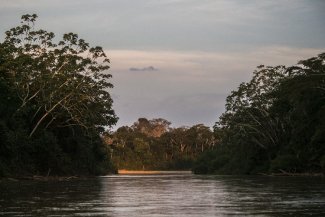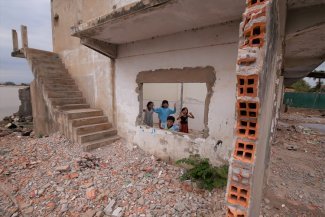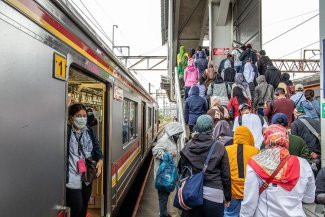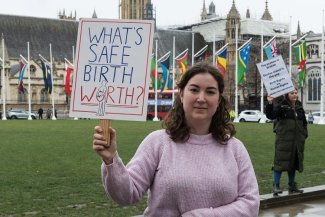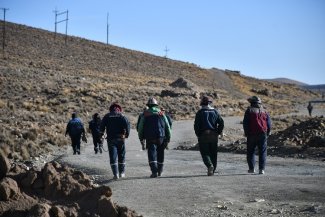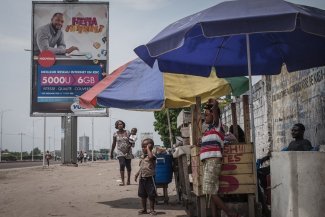
This screengrab taken from aerial video footage taken in on 14 August 14 2022 shows Titik Nol Nusantara (Ground Zero Nusantara), the future capital city for Indonesia, in Sepaku, Penajam Paser Utara, East Kalimantan. Located in eastern Borneo, Nusantara is set to replace sinking and polluted Jakarta as Indonesia’s political centre by late 2024.
In spite of the 17,000 kilometres separating Brazil and Indonesia, both countries have much in common, such as having some of the world’s largest remaining tropical forests. They also share one particular similarity: at some point, during the post-colonial era, its rulers came up with the idea of building a new capital city.
While rulers in Brazil put the idea in practice some 60 years ago by building the current capital, Brasilia, construction of the new Indonesian capital is currently underway. In 2019, the Indonesian national parliament started putting the idea into practice by approving its construction in Kalimantan. What parallels can be drawn between both projects and, most importantly, what lessons can be learnt for social struggles in Indonesia as well as in Brazil?
In Brazil, the idea to build a new capital city is as old as the country’s independence from Portugal, in 1822. The post-colonial elites argued, among others, that Rio de Janeiro, which was the capital since 1763, was a symbol of the colonizers’ influence and that a new capital city would mark a break from the colonial past. They also argued that establishing the capital in the centre of the country would strengthen national unity and bring progress and development to the whole of a nation where the majority of the population lived along the coast. As a result of disputes among the elites over where to build the new capital, Brasilia was only built in the 1950s under the presidency of Juscelino Kubitschek.
Indonesia, in turn, became independent from the Netherlands in 1945. Since then, several presidents expressed their wish to build a new capital city away from Jakarta. In 2019, under the presidency of Joko Widodo and his vice Ma’ruf Amin, the national parliament approved the State Capital Law project to build a new capital city (Ibu Kota Nusantara – IKN) in East Kalimantan. The infrastructure work has already started. The arguments used by Jokowi’s government show parallels with the discourse of the Brazilian rulers: Indonesia should have a new capital as part of its own new and independent history. And as it was argued with Brasilia, the idea of moving the capital to East Kalimantan, at the centre of the archipelago, would further develop the whole of the country, since most of its population and economic activities are currently concentrated on the island of Java, where Jakarta is located.
Deforestation and energy
In the case of Brasilia, 73 per cent of the existing savannah – cerrado in Portuguese – was destroyed during the course of establishing the new capital: the government buildings, business, residential and shopping areas, the necessary transport infrastructure. The new capital city, however, triggered a far-reaching process of deforestation that continues to this day. The building of roads to connect Brasilia with the different states of the federation played a crucial role in this process. One of the first roads to be built was the Transbrasiliana Highway which connects Brasilia with the Amazon city Belém, the capital of Pará state. In addition to the destruction of a significant area of forest to build this 2,000 kilometre road, its construction also opened up the Eastern part of the Amazon region, exposing communities, in particular Indigenous peoples, and their territories to different forms of violence and destructive activities, including timber extraction, cattle breeding, soy and other monoculture plantations, mining activities and the construction of hydroeletric dams.
Those dams, responsible for flooding and thus destroying extensive forest areas, are the backbone of Brasilia’s energy supply. The Itaipu Dam, the world’s second biggest dam in terms of electricity production, ensures 20 per cent of its supply, while the remaining 80 per cent is supplied by the FURNAS system, which is also based on large hydroelectric dams.
Indonesia is starting the project of its new capital city in a very different context than when Brasilia was built. Since then, extensive deforestation on all continents has significantly reduced (tropical) forests. Indonesian rulers, including its elites and international investors and financial institutions such as the World Bank, have actively encouraged forest destruction in the name of ‘development’, in particular in Kalimantan and Sumatra over the past decades.
The climate crisis also creates more serious impacts on the territories every year. In the face of the climate crisis, global elites, corporations and financial institutions have essentially reinvented the fossil-fuel dependent capitalist economy, by presenting it as a so-called ‘green’ or ‘low carbon’ economy.
But behind the shiny new image of the ‘green’ economy hides a logic of capitalist expansion and further exploitation of forests, its peoples and its territories with the aim of increasing corporate profits for the benefit of the elites. Despite the fact that fossil fuels are the main driver of the climate crises, it is under this capitalist framework that corporations and governments formulate most climate and forest-related policies and commitments.
This helps to explain why the Indonesian government is promoting its new capital city as a ‘smart, green and forest’ city. The government argues that the new capital city (IKN) is part of the solution to the global crisis and will help Indonesia achieve its target of ‘net zero emissions’, using renewable energy for its electricity demand and an electric, battery-based, transport system.
However, the 256,000 hectares allegedly needed to construct the new capital city, which is six times the size of the current capital Jakarta, include forest areas that will need to be destroyed. Besides, the ‘renewable’ electricity supply will come from the yet-to-be-built largest hydroelectric power plant (PLTA, in Bahasa Indonesian) in South-East Asia that is fed by five dams on the Kayan River, in Peso District, Bulungan Regency, in North Kalimantan. According to Indonesian activist NGO JATAM in East Kalimantan: “There are six villages that will become victims of this Kayan River hydropower project: Long Lejuh, Long Peso, Long Bia, and Long Pelban villages on the banks of the Kayan River as well as archaeolog¬ical sites in Long Pelban Village, Muara Pangiang and Long Lian. There will be two villages that will be relocated or evicted: Long Pelban and Long Lejuh villages. There are important sites for the Bulungan Indigenous community and sacred tombs (Salung) in Muara Pangean, Long Lejuh, Long Pelban, and Long Lian Villages which get the same threats. There is also a historical heritage of Bulungan ‘Lahai Bara’, a tomb or a sacred site in Long Pelban Village being threatened.”
Moreover, building the new capital city will further trigger the expansion of destructive extractive industries. Besides sand and karst, elephant stone is needed for the infrastructure of the new capital, increasing the destruction created by this type of mining in West and Central Sulawesi. Several islands and its peoples on the eastern side of the archipelago will also suffer from the devastation of nickel extraction, one of the main raw materials in the production of electric vehicle batteries. It is worth noting that these nickel smelters in Indonesia are run on coal-fired power plants (PLTU, in Bahasa Indonesian).
Social apartheid
When Kubitschek’s government started to build Brasilia, it strongly pushed the argument that the new capital city represented a land of dreams and opportunities. It propagated the idea that all people, independent of the class they were born into, would share the same space. Thus, accomplishing the dream of a new capital would also mean accomplishing the dream of a new, equal society.
Nothing could be further from the truth. To begin with, the construction of Brasilia destroyed and reduced territories and cerrado vegetation on which quilombola communities and Indigenous peoples, who have occupied the overall region since time immemorial, depended upon for their survival. Nine years after the capital was inaugurated, about 79,000 people were living in 14,600 tents around Brasilia. In an attempt to halt the migration of more workers attracted by the supposed opportunities that Brasilia would offer them, the government started to remove people from these tent camps to a separate area that later became a new administrative unit called Ceilândia. This was a process comparable to the practices during the apartheid regime of racial segregation from South Africa.
Nowadays, compared with the other 26 Brazilian state capitals, Brasilia is the most unequal one. In 2018, habitants of Lago Sul – a posh neighbourhood full of mansions, tourist attractions and expensive restaurants – enjoyed an average income of 7,654.91 Brazilian reals. Meanwhile, in the neighbourhood of Estrutural, at only 15 km away from Lago Sul, the average income was R$485.97, or 16 times less than in Lago Sul. In contrast to Lago Sul, people in Estrutural face a daily struggle to survive. With poor and expensive transport facilities to reach their workplaces, they face all sorts of problems to attend their basic needs, including affordable food, access to water, energy, sanitation and access to health services.
Although still in its initial phase, the building of Indonesia’s new capital city in Kalimantan seems to be on a similar course. It is destroying and reducing the life spaces of the Indigenous Balik people and other communities in the area, in particular those living in the so-called Ring 1, the most important area of the new capital, reserved for high-level governmental officials and other elites. Ring 2 and Ring 3 will be destined to commerce and industry respectively and to residential neighbourhoods. So far, in what will be Ring 1, Indigenous Balik women whose lives and livelihoods are interwoven with the Sepaku River, have been particularly affected by the initial construction works. Fields, gardens and ancestral graves have been destroyed. Their ancestral knowledge of woven nipa roofs is doomed to disappear if the project of damming rivers to attend the future water supply of the capital city continues, due to the destruction of the areas where the nipa palm occurs.
Who is paying the bill?
The only official figure stating how much the construction of Brasilia cost, estimated in 1960 by the then Minister of Finance of Brazil, Eugênio Gudin, is US$1.5 billion, equivalent to an amount of about US$13 billion today, about R$70 billion .
This looks like a relatively small amount. However, in comparison to the gross national product (GNP) of 1960, building Brasilia consumed 10 per cent of the national budget. Ten per cent of the GNP today would represent about US$140 billion or R$750 billion, a far more significant amount. This amount, nonetheless, still does not give the full picture since a lot of the construction works took place after 1960.
With such a bill, another problem arose: the Brazilian government simply did not have enough money to pay for it. The ‘solution’ adopted was to create more money. This, in turn, contributed to one of the highest inflation rates in the country’s history, leading to considerable price increases of food and other basic products.
It also contributed to a period of political instability that was the precursor of the military coup in 1964, which installed a dictatorship that lasted until 1985.
Indonesia is already a highly indebted country. Who will pay the bill for this mega-project, estimated to cost some US$ 32.7 billion? The government has promised that it will ‘only’ cover 20 per cent of the cost, while investors will pay for the rest. The government claims that many investors are interested. However, these will most likely invest under public-private partnerships, for which the government needs to play the role of a ‘sales marketing manager’, providing tax incentives and tax holidays to ensure investors’ returns and profits. Ultimately, the cost will be borne by the people of Indonesia.
Social struggle as a means of halting and reverting colonialism
Until today, and for over 60 years, the quilombola community that was evicted for the construction of Brasilia continues to struggle to demarcate even a tiny part of what used to be their territory. Similarly, the Balik people who are facing the construction of the new capital city in Indonesia continue to raise their voices.
Dahlia is a dancer from a Balik community in the area where the new capital is planned. She says: “I can’t imagine what will happen when the project is ready to be implemented […]. No one wants to hear our voices. I want to cry and scream. I feel like we are being colonised even though we are in a free and independent country.”
A striking parallel between both stories of the new capital cities is how both projects only reinforce a colonial state, in spite of their promoters claiming the opposite. Both projects dominate and destroy the life spaces and territories of forest communities for economic and political interests. And both new capital cities also promote policies of social apartheid.
Both stories, however, also show the role of social struggles as a way to put a halt to and revert a history of colonialism and other structural oppressions that include racism, capitalism and patriarchy.
Behind the discourses of the presidents and the false propaganda about the new capital cities, communities in both countries are the protagonists of the struggles to defend and reclaim their lands, rivers and forests on which their culture and identity depend.
When the military dictatorship in Brazil ‘opened up’ the country from 1964 onwards, to ensure profits for Brazilian and in particular international elites, their project was to ‘kill’ the culture and identity of Indigenous peoples and other traditional communities by forcibly integrating them into the larger, so-called ‘modern’ society. But Indigenous peoples continued resisting. In 1980, the first Indigenous organisation was founded in the Amazon state of Acre, called UNI, and about 500 others followed in the years after. Together with other social movements, their resistance became so strong that it overthrew the military in power. A new Constitution laid the basis for repairing a small part of the historical debt towards Indigenous and other traditional communities. The fact that nowadays 26 per cent of Amazon territory is controlled by Indigenous peoples, however, is not just because of that new Constitution. It is a result, above all, of social struggles that keep putting pressure on a state structure that continues to rule for wealthy private interests and which maintains many colonial traces.
The government of Indonesia is still in the very initial stage of building its new capital city, and thus, there is still the chance to cancel the project. As the example of Brasilia shows, building a new capital city has nothing to do with building an independent country and breaking with the colonial era. Indigenous peoples hold the key to understanding what breaking with the colonial past entails. This includes a fundamental change in the state’s relationship with the people living in its territories, and with the territories themselves, one that needs to stop listening to the wealthy national and foreign investors. That would be a first real step towards decolonising the country.



